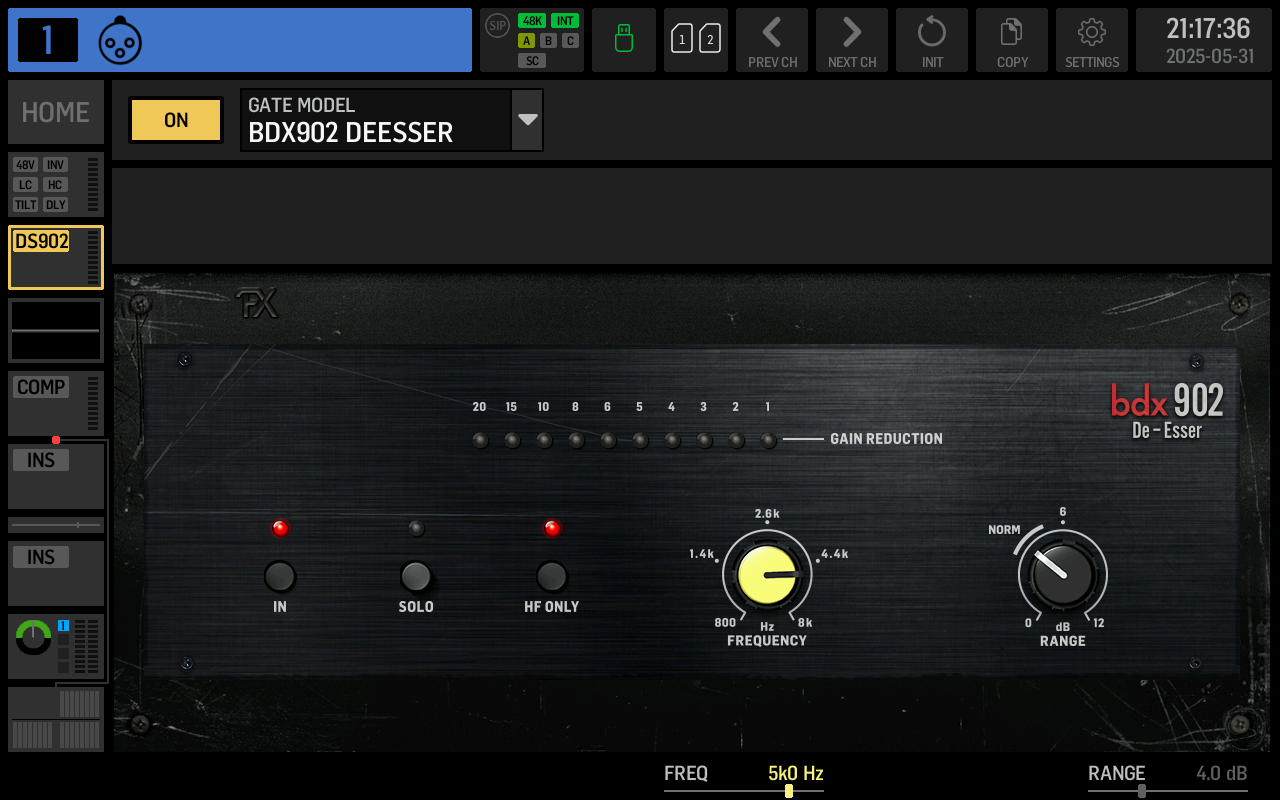BDX 902 DEESSER

BDX 902 De-Esser - DBX 902
该效果器受 dbx 902 去齿声器的启发。FREQUENCY 旋钮设置侧链滤波器的中心频率,RANGE 控制衰减量。
如果 HF ONLY 未启用,当侧链滤波器通过的频率超过固定阈值时,整个输入信号将被衰减。如果 HF ONLY 已启用,则只会衰减 FREQUENCY 旋钮设定的高频范围。
dbx 902 去咝声器是为 F900A 主机或 FS900 小型框架设计的。902 的独特功能使其有可能实现所需的精确去咝声量,而不受信号电平变化的影响。
- 对数域处理: 902 检查信号的高频部分和全频带部分之间的分贝差异,允许对电平变化高达 60 分贝的信号进行除咝声。传统的除咝声器需要在人声从歌唱的声音下降到低语的声音时重新调整其阈值控制。相比之下,902 甚至没有一个需要调整的阈值控制。
- 用户自定义的分频器频率/仅高频或频带操作: 902 用于分离高频和低频的两极、最大平坦的滤波器设计,可由用户在 800Hz 至 8kHz 的范围内进行调整。这与仅高频模式相结合,使 902 可用于特殊的、非人声的应用,如去除近距离麦克风的吉他的 “咔嗒声”。
- RMS 电平检测: dbx 专利的 RMS 电平检测器使 902 在与人耳相同的基础上感知电平–对音频波形提供自然和准确的响应。
其他功能
- 控制电压输入和输出
- 扩大范围的 LED 电平表
- 硬接线侧链开关
前面板操作
GAIN REDUCTION(增益衰减)
- 以分贝为单位显示衰减的量。
IN(输入/输出开关)
- 允许用户用硬接线绕过 902 进行前/后比较。控制器和指示器在侧链模式下继续发挥作用。
- 对于去咝咝声,它应保留在正常模式下。
SOLO
- 按下后,只会听到被过滤器检测到的信号,用于确定应该应用增益衰减的频率。
- 调整频率,使其最能捕捉到咝咝声。
HF ONLY(仅高频开关)
- 允许 902 去咝咝声的动作影响整个音频频带,或只影响高频。
- 对于一些器乐素材的 "除杂 "和 “除咔”,它应该放在仅高频模式下。
- 对于人声,应该关掉。
FREQUENCY(频率控制)
- 选择 902 将音频信号分割成高频和低频部分进行评估的频率。902 通过比较音频信号的高频电平和信号的全频带电平(以 dB 为单位)来检测咝声素材。当高频电平相对于全带宽电平过高时,902 将去咝咝声。
- 对于正常的人声去咝咝声,这个旋钮应该设置在 12:00 左右的位置(2.5kHz)。
- 对于器乐素材的特殊处理,该控制应该来回扫动,直到获得最佳设置。
RANGE(范围控制)
- 用于设定检测到咝咝声时产生的去咝咝声效果的量。
- 如果你想更多地衰减信号,把 “RANGE” 旋钮转到右边。
- 对于正常的人声咝咝声,让这个旋钮处于 NORM 区域。超出这个范围的数值,长时间听起来可能会不自然。
- 更加极端的设置对特殊效果和处理乐器素材很有用。
其他说明
- 902 除咝声器的主要设计目标之一,是在对各种人声素材进行除咝咝声时不再需要任何调整。然而,通过提供的用户控制,还可以获得其他一些有趣的和值得的效果。通过调整滤波器的截止频率和最大的增益降低量,可以在动态的基础上改变某些敲击性源素材的高端。例如,在不影响吉他音色的情况下,可以完全消除吉他轨道上的拨弦噪音。当吉他弦被敲击时,产生的第一个声音是高电平、高频率的 "咔嗒 "声,基本弦振动的振幅相对缓慢地建立起来。通过去咝咝声处理吉他音轨,通过正常的高频增强均衡,音轨可以被大大地提亮,而不会夸大恼人的拨弦声。
BDX902 DeEsser is modeled after the dbx model 902 De-Esser. According to the dbx documentation, “The 902’s unique features make it possible to achieve the exact amount of de-essing desired regardless of variations in signal levels.”
Log-Domain Processing: The 902 examines the differences in dB between the high frequency and full-bandwidth portions of the signal, allowing de-essing of signals which change in level by as much as 60 dB. Conventional de-essers require readjustment of their threshold control when a vocalist drops from singing voice to a whispering voice. By contrast, the 902 does not even have a threshold control to require adjustment.
User-Defined Crossover Frequency: The two-pole, maximally flat filter design used by the 902 in separating high frequencies from low frequencies can be user adjusted over a range of 800 Hz to 8 kHz.
RMS Level Detection: dbx patented RMS level detectors enable the 902 to sense level on the same basis as the human ear — providing a natural and accurate response to audio waveforms.
All of that means that this is a very simple and transparent de-esser!
使用
IN – This is the active/bypass switch. When the light is on, the BDX902 is in an active state. For de-essing, the default is to leave this ON. SOLO – The Solo button activates a solo of the control portion of the de-esser, press this to help tune to the right frequency portion of the signal for setting the frequency knob. For de-essing, the default is to leave this OFF. HF ONLY – Allows the 902 de-essing action to affect either the entire audio bandwidth, or the high frequencies only. For de-essing, the default is to leave this ON. FREQUENCY – Using the Frequency knob allows us to choose the frequency at which the BDX902 divides the audio signal into high and low-frequency parts for assessment. The 902 detects sibilant material by comparing the high-frequency level of an audio signal and the signal’s full bandwidth level in decibels (dB). When the high-frequency level significantly exceeds the full bandwidth level, the BDX902 will initiate the de-essing process. For standard vocal de-essing, set this control to approximately the 12:00 position (2.5 kHz). If you are processing instrumental material in a unique way, adjust the control back and forth until you find the optimal setting. RANGE – This control determines the level of the de-essing effect when detecting sibilance. For standard vocal de-essing, keep this control within the NORMAL range. If you turn the RANGE control clockwise past the NORMAL range, it will overly reduce vocal sibilance or make it sound muffled. More extreme settings are suitable for special effects and processing instrumental material. While the BDX902 remains effectively imperceptible during regular “de-essing” operation (sibilants continue to sound natural), there might be a tendency to excessively adjust the range control clockwise beyond the normal range. However, prolonged listening will reveal that this extra de-essing effect sounds unnatural for vocals.
应用
The BDX902 de-esser is designed primarily to eliminate the need for adjustments when de-essing various vocal materials. The user controls also offer the opportunity to achieve interesting and valuable effects. You can modify the high end of specific percussive source materials dynamically by adjusting the filter cutoff frequency and the maximum gain reduction. For instance, you can completely remove the pick noise from a guitar track without affecting the guitar’s timbre. When a guitar string is struck, it initially produces a high-level, high-frequency ‘click,’ with the fundamental string vibration’s amplitude gradually increasing. Processing a guitar track through the de-esser can significantly enhance its brightness through standard high-frequency equalization, without overemphasizing annoying pick noises.
参考设置
BDX902 De-Esser for Speaking: I find that using the BDX902 on a speaking microphone is one of the best uses for this de-esser. When setting this up I will start with these settings and then adjust the Frequency knob until I hear a more pleasant essing. After that, I will then reach for the range knob to increase or decrease the amount of de-essing.
IN: ON SOLO: OFF HF ONLY: ON FREQUENCY: 3 kHz RANGE: NORMAL to 6 dB
BDX902 De-Esser for Singing: IN: ON SOLO: OFF HF ONLY: ON FREQUENCY: 4.4 kHz RANGE: NORMAL to 6 dB
BDX902 on Acoustic Guitar: IN: ON SOLO: OFF HF ONLY: ON FREQUENCY: 6 kHz RANGE: 6 dB to 12 dB